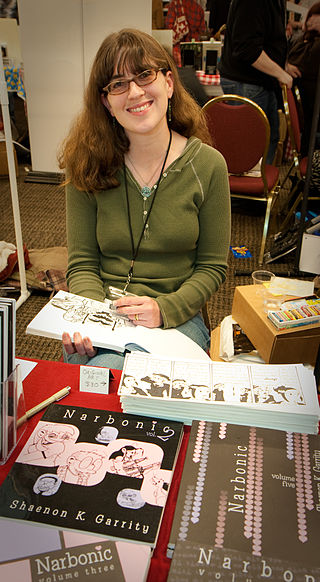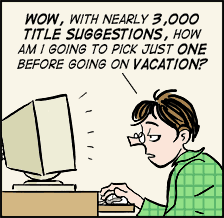Webcomics are comics published on the internet, such as on a website or a mobile app. While many webcomics are published exclusively online, others are also published in magazines, newspapers, or comic books.
8-Bit Theater is a sprite comic, meaning the art is mainly taken from pre-existing video game assets, created by Brian Clevinger that ran from 2001 to 2010 and consisting of 1,225 pages. The webcomic was, at times, one of the most popular webcomics, and the most popular sprite comic.
Bob and George was a sprite-based webcomic which parodied the fictional universe of Mega Man. It was written by David Anez, who at the time was a physics instructor living in the American Midwest. The comic first appeared on April 1, 2000, and ran until July 28, 2007. It was updated daily, with there being only 29 days without a comic in its seven years of production and with 2568 comics being made altogether.

Shaenon K. Garrity is an American webcomic creator and science-fiction author best known for her webcomics Narbonic and Skin Horse. She collaborated with various artists to write webcomics for the Modern Tales-family of webcomic subscription services in the early 2000s, and write columns for various comics journals. Since 2003, Garrity has done freelance editing for Viz Media on various manga translations.
A Softer World is a webcomic by the writer Joey Comeau and artist Emily Horne, both Canadians. It was first published online on 7 February 2003 and was released three times a week until its end in June 2015. Before starting the website in 2003, the comics had been published in zine form. With the launch of the website, the comic gained wider recognition, most notably when Warren Ellis linked to the comic on his blog, and then began to feature it as a "Favored Puny Human". It appeared in The Guardian for a short time until a change of editors caused it to be removed. Between 2008 and 2010, science fiction-themed strips of A Softer World were also produced and published on Tor.com.
Alien Loves Predator is a webcomic written by Bernie Hou. It spoofs the Alien vs. Predator franchise. Reversing the adversarial relationship depicted in the comics, games, books and movies, ALP presents an Alien and a Predator as friends and roommates in modern-day New York City.
Chris Crosby is a co-founder and the chief executive officer of Keenspot, a company providing a platform and network for webcomics. They are also a comics writer and artist, with works including Superosity, Sore Thumbs, and Snap The Punk Turtle.
Girlamatic was a webcomic subscription service launched by Joey Manley and Lea Hernandez in March 2003. It was the third online magazine Manley established as part of his Modern Tales family of websites. Girlamatic was created as a place where both female artists and readers could feel comfortable and featured a diverse mix of genres. When the site launched, the most recent webcomic pages and strips were free, and the website's archives were available by subscription. The editorial role was held by Hernandez from 2003 until 2006, when it was taken over by Arcana Jayne-creator Lisa Jonté, one of the site's original artists. In 2009, Girlamatic was relaunched as a free digital magazine, this time edited by Spades-creator Diana McQueen. The archives of the webcomics that ran on Girlamatic remained freely available until the website was discontinued in 2013.

Faith Erin Hicks is a Canadian cartoonist and animator living in Vancouver, British Columbia.
The Web Cartoonists' Choice Awards (WCCA) were annual awards in which established webcartoonists nominated and selected outstanding webcomics. The awards were held between 2001 and 2008, were mentioned in a New York Times column on webcomics in 2005, and have been mentioned as a tool for librarians.
The Dreamland Chronicles is an all-ages fantasy webcomic and comic book series created by Scott Christian Sava with 3D computer graphics.
The history of comics has followed different paths in different parts of the world. It can be traced back to early precursors such as Trajan's Column, in Rome, Egyptian hieroglyphs and the Bayeux Tapestry.
Sluggy Freelance is a long-running webcomic written and drawn by Pete Abrams. Starting in 1997, it is one of the oldest successful webcomics, and as of 2012 had hundreds of thousands of readers. Abrams was one of the first comic artists successful enough to make a living from a webcomic.

Lackadaisy is a webcomic created by American artist Tracy J. Butler. Set in a Prohibition-era St. Louis with a population of anthropomorphic cats, the plot chronicles the fortunes of the Lackadaisy speakeasy after its founder is murdered. The comic mixes elements of comedy, crime and mystery. It won multiple Web Cartoonists' Choice Awards in 2007 and 2008, and in April 2011 it was nominated for the Eisner Award for "Best Digital Comic".
The history of webcomics follows the advances of technology, art, and business of comics on the Internet. The first comics were shared through the Internet in the mid-1980s. Some early webcomics were derivatives from print comics, but when the World Wide Web became widely popular in the mid-1990s, more people started creating comics exclusively for this medium. By the year 2000, various webcomic creators were financially successful and webcomics became more artistically recognized.
Notable events of 2002 in webcomics.
Notable events of the late 1990s in webcomics.

The Morning Improv is a series of webcomics created by Scott McCloud from 2001 to 2004. The series was entirely improvisational, as McCloud wrote one or two panels every morning. The title of each of the 26 webcomics McCloud created for The Morning Improv were selected by his readers.




